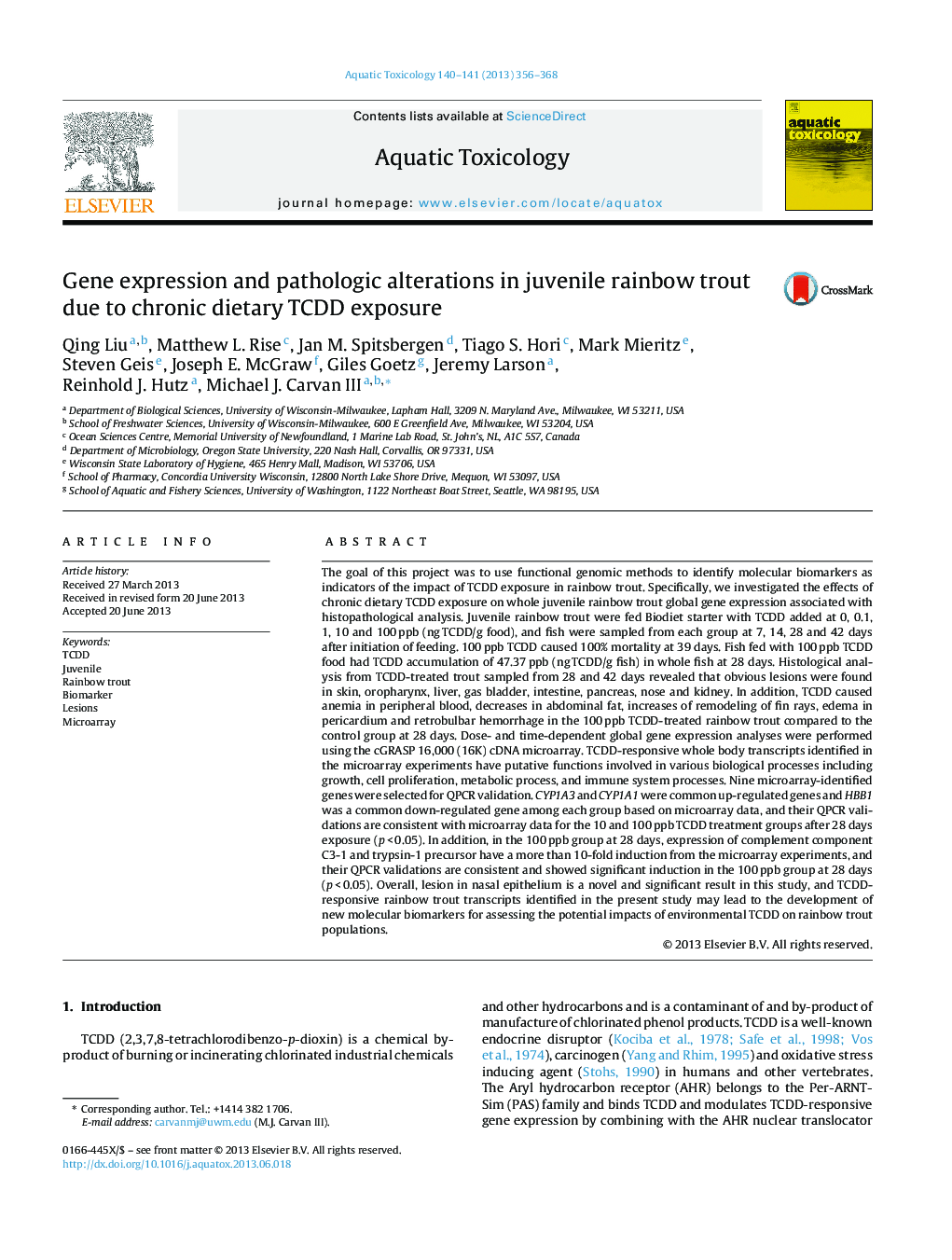| کد مقاله | کد نشریه | سال انتشار | مقاله انگلیسی | نسخه تمام متن |
|---|---|---|---|---|
| 6382555 | 1625962 | 2013 | 13 صفحه PDF | دانلود رایگان |

- First report of the effects of dietary TCDD in juvenile trout smaller than 20Â g.
- TCDD uptake was estimated using published models and confirmed by GC.
- First report of dietary TCDD-induced lesions in nasal epithelium in any species.
- Several useful biomarkers are identified from microarray-based transcriptomics analysis.
The goal of this project was to use functional genomic methods to identify molecular biomarkers as indicators of the impact of TCDD exposure in rainbow trout. Specifically, we investigated the effects of chronic dietary TCDD exposure on whole juvenile rainbow trout global gene expression associated with histopathological analysis. Juvenile rainbow trout were fed Biodiet starter with TCDD added at 0, 0.1, 1, 10 and 100 ppb (ng TCDD/g food), and fish were sampled from each group at 7, 14, 28 and 42 days after initiation of feeding. 100 ppb TCDD caused 100% mortality at 39 days. Fish fed with 100 ppb TCDD food had TCDD accumulation of 47.37 ppb (ng TCDD/g fish) in whole fish at 28 days. Histological analysis from TCDD-treated trout sampled from 28 and 42 days revealed that obvious lesions were found in skin, oropharynx, liver, gas bladder, intestine, pancreas, nose and kidney. In addition, TCDD caused anemia in peripheral blood, decreases in abdominal fat, increases of remodeling of fin rays, edema in pericardium and retrobulbar hemorrhage in the 100 ppb TCDD-treated rainbow trout compared to the control group at 28 days. Dose- and time-dependent global gene expression analyses were performed using the cGRASP 16,000 (16K) cDNA microarray. TCDD-responsive whole body transcripts identified in the microarray experiments have putative functions involved in various biological processes including growth, cell proliferation, metabolic process, and immune system processes. Nine microarray-identified genes were selected for QPCR validation. CYP1A3 and CYP1A1 were common up-regulated genes and HBB1 was a common down-regulated gene among each group based on microarray data, and their QPCR validations are consistent with microarray data for the 10 and 100 ppb TCDD treatment groups after 28 days exposure (p < 0.05). In addition, in the 100 ppb group at 28 days, expression of complement component C3-1 and trypsin-1 precursor have a more than 10-fold induction from the microarray experiments, and their QPCR validations are consistent and showed significant induction in the 100 ppb group at 28 days (p < 0.05). Overall, lesion in nasal epithelium is a novel and significant result in this study, and TCDD-responsive rainbow trout transcripts identified in the present study may lead to the development of new molecular biomarkers for assessing the potential impacts of environmental TCDD on rainbow trout populations.
Journal: Aquatic Toxicology - Volumes 140â141, 15 September 2013, Pages 356-368